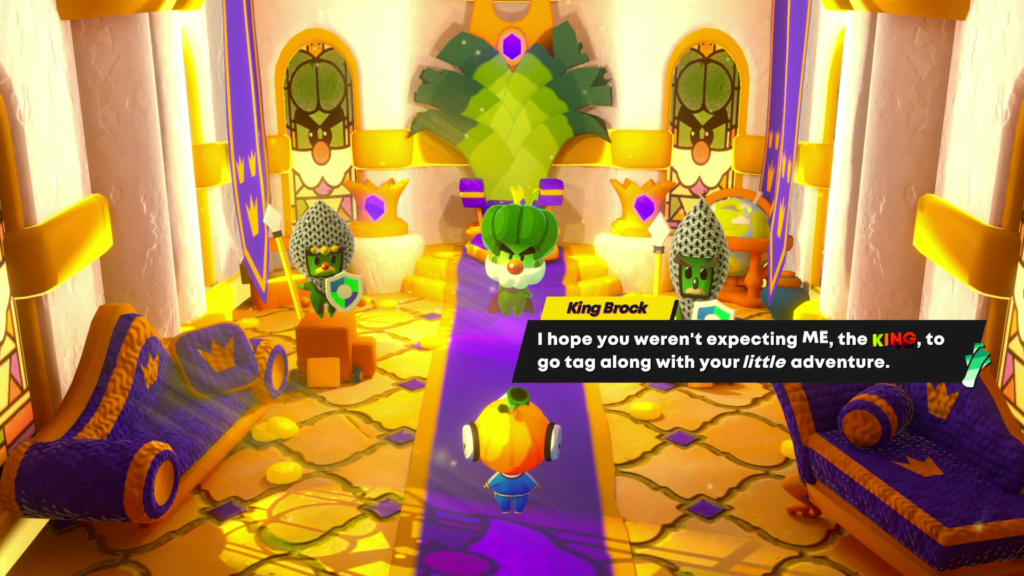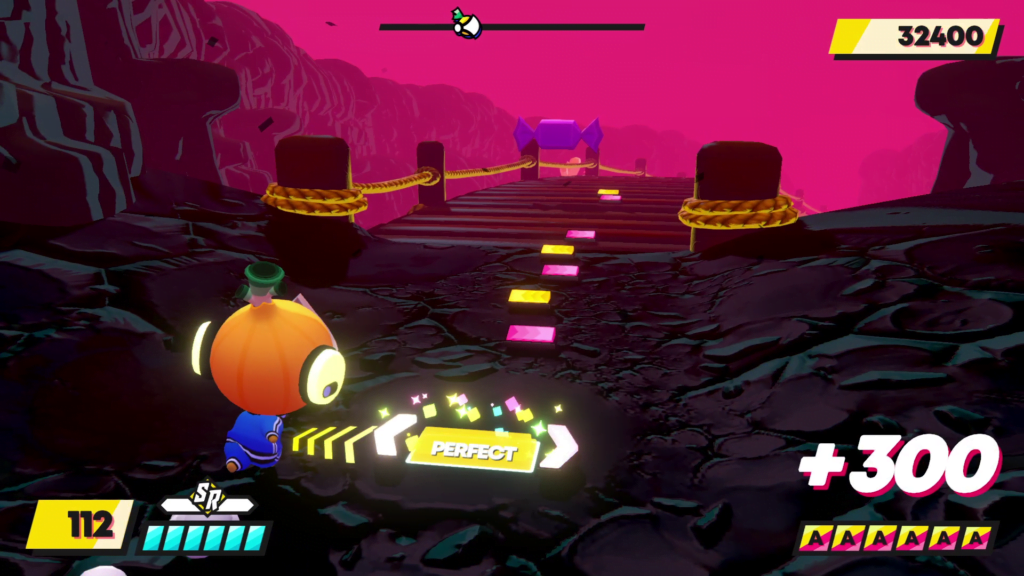One of things I love most about rhythm games is the variety of ideas they have. You don’t have to look far to see a number of different takes on how to creatively play along to music. Sometimes it’s as simple as just throwing a bunch of inputs on screen (or spin a wheel in some cases) while some wild visuals play in the background, other times it means playing an endless runner or something far more abstract instead. The possibilities are seemingly endless. Rhythm Sprout: Sick Beats & Bad Sweets stands somewhere around the middle of the extremes. It’s very straightforward in terms of presentation, but inventive and fun in terms of the actual actions happening on screen.
Rhythm Sprout follows the titular Sprout on a quest to defeat King Sugar Daddy and stop his invasion of the Vegetable Kingdom. Every level sees Sprout marching forward to his destination, vanquishing any foes who stand in his way in time to the music. Every successful note moves him forward one step at a time, his headphones flashing in time to the beat as the music propels him onward.
The story is… fine. It tries to be funny to a fault. Every cutscene needs to have a gag and that gag needs to be used to its fullest. The very first cutscene demonstrates what you’re in for perfectly: King Brock, an anthropomorphized head of broccoli, is explaining the situation to Sprout, knight to the kingdom and the “chosen onion,” who apparently wasn’t paying attention the first time and is now explaining it again. His demeanor is belligerent, often insulting Sprout, and forgetful, regularly going off on some tangent and asking what he was talking about. He’s a constant presence, frequently calling to check in Sprout’s progress only to repeat his shtick to the point of becoming grating. This extends to other characters as well, who tend to have their gags go on similarly too long.

Rhythm Sprout‘s writing really wants to be funny no matter how forced it feels or how little meat the material has and in doing so falls flat. Everything feels stretched too thin. The material can’t land when it’s constantly trying to insert humor. I was ready to skip most scenes after the first several levels because there wasn’t really anything of import happening and the scenes kept feeling more protracted, the humor wearing more and more thin all the while.
As a rhythm game, however, Rhythm Sprout is excellent. Rhythm Sprout uses three buttons: any of the d-pad directions, any of the face buttons, and one of the two bumpers. Left and right notes are handled by the d-pad and face buttons respectively, while dodges are done by pressing one of the bumpers.
The dodge notes mostly appear in combat, which is denoted by Sprout drawing his sword and fighting whatever foe is before him until their life bar is depleted. Successfully hitting them allows Sprout to avoid whatever attack the enemy deals. Sprout has several hit-points by default and is able to restore them by chaining notes together successfully (one point for every 20-note chain). Missing notes doesn’t automatically deplete his HP, thankfully. You can just sit there and let them pass you by until you think you’re ready to get back on beat, which is surprisingly lenient. (Dodge notes still need to be hit, though.)

But even so, the game lies a bit on the harder side of the genre. While the first few levels are simple, it doesn’t take long for the tracks to become demanding. It starts off with music that has a steady, mellow rhythm that’s easy to pick up on, usually repeating the same note patterns for long stretches before making any changes. But as the tempo picks up, so too does the difficulty: the space between notes decreases, forcing you to be very fast and precise; the patterns become more complex and irregular, making it harder to settle into the rhythm instantly; trap notes start appearing occasionally, requiring an extra degree of precision. Standard rhythm game stuff for the most part.
For most levels, it’s not that bad. It’s mostly akin to playing a track in any other music game on higher difficulty levels. Challenging, but not overwhelming. The process of learning each level and steadily getting longer and longer chains of notes, inching closer and closer to a full, perfect clear remains enthralling as ever. At a certain point, however, I had to turn on beginner mode to get past some levels because I couldn’t keep up with the beat otherwise. Notes eventually start coming at such a rapid pace, with so little room between them, that you need to mash with incredible speed and precision. And even then, it was still pretty difficult. In part this is a natural consequence of the way the notes are laid out to keep up with the beat of the music (the music becomes quite busy in late-game stages), but it’s also a consequence of Rhythm Sprout’s approach to difficulty.
Where traditionally a lot of rhythm games let you choose a difficulty level and create different note patterns to match, Rhythm Sprout only uses the one made for each level. The actual layout of the note pattern doesn’t change. What you see is what you get. What beginner mode does, then, is make it so you only need to press one button to hit any of the left and right notes, reducing the number of buttons you need to press down to two instead of three (dodges still require you press one of the bumpers). The game does say it makes the timing more lenient as well, but I couldn’t tell you by how much. The biggest boon is that it gives you more hit-points to work with, which gives you far more leeway if you’re not able to consistently chain notes, and removes the trap notes entirely. Paired with its leniency for missing notes, it’s a good way to scale difficulty. I don’t know if it’s better than the traditional method, though.

Being able to slowly increase the difficulty and complexity of songs is one of the things that makes rhythm games approachable. This is a genre that is inherently difficult, so providing the tools for people to make the onramp more accommodating is ideal. Rhythm Sprout‘s method works – beginner mode definitely helps make the hardest levels much more manageable – but it doesn’t feel quite as effective as standard modal difficulty options since it still requires you to play each track as designed rather than allow you to find a balance that works for you. I’m someone who enjoys trying to play songs at their most complex, but I also know I’m not often able to actually do so. Being able to lower the difficulty just a little bit – make some note clusters a bit less demanding, maybe – and find what works best for me is ideal then, and I found myself wishing that were an option a few times.
If, on the other hand, you want a greater challenge, “EX Modes” are unlocked after completing each level that can make them harder. You can increase the speed of the level, mirror the notes, or outright randomize the notes entirely. Randomizing notes is a fun twist since it turns the game into one of raw reactions rather than building muscle memory, but they’re mostly a novelty.
It does speak to where Rhythm Sprout‘s interests in difficulty tend to lie, though. It’s a game that has a clear interest in providing challenge wherever possible, and it’s very good at doing that. It thankfully doesn’t forget approachability in that pursuit, but your mileage may vary on its effectiveness. If you’re able to put up with some of the more demanding levels, though, Rhythm Sprout is worth your time.





